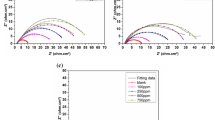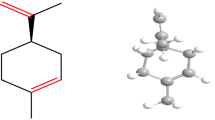Abstract
The aim of the present work was to evaluate the inhibition effect of cinnamon essential oil (CEO) on mild steel corrosion in 1.0 M HCl. Its antioxidant activity was also analyzed. The CEO characteristics were studied using a chromatography-flame ionization detector, gas chromatography-mass spectrometry analysis, potentiodynamic polarization, electrochemical impedance spectroscopy, and scanning electron microscopy coupled with energy dispersive X-ray spectroscopy, and weight loss measurements, the results achieved via different techniques were in excellent agreement. The inhibition efficiency of CEO exceeded 92% at 1.0 g/L at 298 K and increased with increasing the oil concentration but decreased slightly with an increase of temperature. The adsorption of the inhibitor on the surface of mild steel followed best the Langmuir isotherm model. The scanning electron microscopy and energy dispersive X-ray spectroscopy data confirmed the formation of a protective film on the surface of the mild steel.











Similar content being viewed by others
REFERENCES
Zhang, L., Liu, S., Han, H., Zhou, Y., et al., Studies on the formation process and anti-corrosion performance of polypyrrole film deposited on the surface of Q235 steel by an electrochemical method, Surf. Coat. Technol., 2018, vol. 341, p. 95.
Angst, U.M., Challenges and opportunities in corrosion of steel in concrete, Mater. Struct., 2018, vol. 51, p. 4.
Ech-chihbi, E., Belghiti, M.E., Salim, R., Oudda, H., et al., Experimental and computational studies on the inhibition performance of the organic compound “2‑phenylimidazo [1,2-a]pyrimidine-3-carbaldehyde” against the corrosion of carbon steel in 1.0 M HCl solution, Surf. Interfaces, 2017, vol. 9, p. 206.
El Hajjaji, F., Abrigach, F., Hamed, O., Hasan, A.R., et al., Corrosion resistance of mild steel coated with organic material containing pyrazol moiety, Coatings, 2018, vol. 8, p. 330.
Bouoidina, A., Chaouch, M., Abdellaoui, A., Lahkimi, A., et al., Essential oil of “Foeniculum vulgare”: Antioxidant and corrosion inhibitor on mild steel immersed in hydrochloric medium, Anti-Corros. Methods Mater., 2017, vol. 64, p. 563.
Farssi, M., Batah, A., Belkhouda, M., Salghi, R., et al., Green inhibition of carbon steel corrosion by fish oil in hydrochloric acid medium, J. Ind. Eng. Chem., 2020, vol. 8, p. 474.
Znini, M., Majidi, L., Bouyanzer, A., Paolini, J., et al., Essential oil of Salvia aucheri mesatlantica as a green inhibitor for the corrosion of steel in 0.5 M H2SO4, Arab. J. Chem., 2012, vol. 5, p. 467.
Dahmani, K., Galai, M., Cherkaoui, M., El Hasnaoui, A., et al., Cinnamon essential oil as a novel eco-friendly corrosion inhibitor of copper in 0.5 M sulfuric acid medium, J. Mater. Environ. Sci., 2017, vol. 8, no. 5, p. 1676.
Bammou, L., Chebli, B., Salghi, R., Bazzi, L., et al., Thermodynamic properties of Thymus satureioides essential oils as corrosion inhibitor of tinplate in 0.5 M HCl: Chemical characterization and electrochemical study, Green Chem. Lett. Rev., 2010, vol. 3, p. 173.
Tarfaoui, K., Ouakki, M., Galai, M., Nehiri, M., et al., Valorization of the essential oil of Zingiber officinale by its use as inhibitor against the corrosion of the carbon steel in acid medium hydrochloric acid 1 M, Mediterr. J. Chem., 2019, vol. 8, no. 1, p. 17.
Chraka, A., Raissouni, I., Benseddik, N., Khayar, S., et al., Aging time effect of Ammi visnaga (L.) lam essential oil on the chemical composition and corrosion inhibition of brass in 3% NaCl medium. Experimental and theoretical studies, Mater. Today, 2020, vol. 22, p. 83.
Haida, S., Bakkouche, K., Ouakki, M., Galai, M., et al., Cistus monspeliensis extract as antioxidant and corrosion inhibitor of ordinary steel in 1 M hydrochloric acid medium, Mediterr. J. Chem., 2020, vol. 10, no 2, p. 185.
El Atki, Y., Aouam, I., El Kamari, F., Taroq, A., et al., Antibacterial activity of cinnamon essential oils and their synergistic potential with antibiotics, J. Adv. Pharm. Technol. Res., 2019, vol. 10, p. 63.
Adams, R.P., Identification of Essential Oil Components by Gas Chromatography/Mass Spectrometry, Carol Stream, IL: Allured, 2007, 4th ed.
Wu, H.C., Chen, H.M., and Shiau, C.Y., Free amino acids and peptides as related to antioxidant properties in protein hydrolysates of mackerel (Scomber austriasicus), Food Res. Int., 2003, vol. 36, p. 949.
Prieto, P., Pineda, M., and Aguilar, M., Spectrophotometric quantitation of antioxidant capacity through the formation of a phosphomolybdenum complex: specific application to the determination of vitamin E, Anal. Biochem., 1999, vol. 269, p. 337.
Ech-chihbi, E., Salim, R., Oudda, H., Elaatiaoui, A., et al., Effect of some imidazopyridine compounds on carbon steel corrosion in hydrochloric acid solution. Pharma Chem., 2016, vol. 8, p. 214.
Singh, G., Maurya, S., DeLampasona, M.P., and Catalan, C.A.N., A comparison of chemical, antioxidant and antimicrobial studies of cinnamon leaf and bark volatile oils, oleoresins and their constituents, Food Chem. Toxicol., 2007, vol. 45, p. 1650.
Lu, F., Ding, Y.C., Ye, X.Q., and Ding, Y.T., Antibacterial effect of cinnamon oil combined with thyme or clove oil, Agric. Sci. China, 2011, vol. 10, p. 1482.
Simić, A., Soković, M.D., Ristić, M., Grujić-Jovanović, S., et al., The chemical composition of some Lauraceae essential oils and their antifungal activities, Phyther. Res., 2004, vol. 18, p. 713.
Boumhara, K., Tabyaoui, M., Jama, C., and Bentiss, F., Artemisia mesatlantica essential oil as green inhibitor for carbon steel corrosion in 1 M HCl solution: Electrochemical and XPS investigations, J. Ind. Eng. Chem., 2015, vol. 29, p. 146.
Bensouda, Z., El Assiri, E.H., Sfaira, M., Ebn Touhami, M., et al., Extraction, Characterization and Anticorrosion Potential of an Essential Oil from Orange Zest as Eco-Friendly Inhibitor for Mild Steel in Acidic Solution, J. Bio- Tribo-Corros., 2019, vol. 5, p. 84.
Bensouda, Z., Elassiri, E., Galai, M., Sfaira, M., et al., Corrosion inhibition of mild steel in 1 M HCl solution by Artemisia abrotanum essential oil as an eco-friendly inhibitor, J. Mater. Environ. Sci., 2018, vol. 9, p. 1851.
El Hajjaji, F., Greche, H., Taleb, M., Chetouani, A., et al., Application of essential oil of thyme vulgaris as green corrosion inhibitor for mild steel in 1 M HCl, J. Mater. Environ. Sci., 2016, vol. 7, p. 567.
Ismaily Alaoui, K., Ouazzani, F., Kandri Rodi, Y., Azaroual, A.M., et al., Effect of some benzimidazolone compounds on C38 steel corrosion in hydrochloric acid solution, J. Mater. Environ. Sci., 2016, vol. 7, p. 244.
Rahmani, H., Ismaily Alaoui, K., Emran, K.M., El Hallaoui, A., et al., Experimental and DFT investigation on the corrosion inhibition of mild steel by 1,2,3-triazole regioisomers in 1 M hydrochloric acid solution, Int. J. Electrochem. Sci., 2019, vol. 14, p. 985.
Kalaiselvi, K., Chung, I.M., Kim, S.H., and Prabakaran, M., Corrosion resistance of mild steel in sulphuric acid solution by Coreopsis tinctoria extract: Electrochemical and surface studies, Anti-Corros. Methods Mater., 2019, vol. 65, no. 4, p. 408.
Dehghani, A., Bahlakeh, G., Ramezanzadeh, B., and Ramezanzadeh, M., Detailed macro-/micro-scale exploration of the excellent active corrosion inhibition of a novel environmentally friendly green inhibitor for carbon steel in acidic environments, J. Taiwan Inst. Chem. Eng., 2019, vol. 100 p. 239.
Lorenz, W.J. and Mansfeld, F., Determination of corrosion rates by electrochemical DC and AC methods, Corros. Sci., 1981, vol. 21, p. 647.
Tourabi, M., Nohair, K., Nyassi, A., Hammouti, B., et al., Thermodynamic characterization of metal dissolution and inhibitor adsorption processes in mild steel/3,5-bis(3,4-dimethoxyphenyl)-4-amino1,2,4-triazole/hydrochloric acid system, J. Mater. Environ. Sci., 2014, vol. 4, p. 1133.
Echchihbi, E., Nahle, A., Salim, R., Oudda, H., et al., An investigation into quantum chemistry and experimental evaluation of imidazopyridine derivatives as corrosion inhibitors for C-steel in acidic media, J. Bio- Tribo-Corros., 2019, vol. 5, p. 24.
Bentiss, F., Traisnel, M., Vezin, H., Hildebrand, H.F., et al., 2,5-Bis(4-dimethylaminophenyl)-1,3,4-oxadiazole and 2,5-bis(4-dimethylaminophenyl)-1,3,4-thiadiazole as corrosion inhibitors for mild steel in acidic media, Corros. Sci., 2004, vol. 46, p. 2781.
El-Hajjaji, F., Messali, M., Martínez de Yuso, M.V., Rodríguez-Castellón, E., et al., Effect of 1-(3-phenoxypropyl) pyridazin-1-ium bromide on steel corrosion inhibition in acidic medium, J. Colloid Interface Sci., 2019, vol. 541, p. 418.
Tourabi, M., Nohair, K., Nyassi, A., Hammouti, B., et al., Thermodynamic characterization of metal dissolution and inhibitor adsorption processes in mild steel/3,5-bis(3,4-dimethoxyphenyl)-4-amino1,2,4-triazole/hydrochloric acid system, J. Mater. Environ. Sci., 2014, vol. 5, p. 1133.
Soltani, N., Salavati, H., Rasouli, N., Paziresh, M., et al., Electrochemical and quantum chemical calculations of two Schiff bases as inhibitor for mild steel corrosion in hydrochloric acid solution, Iran. J. Anal. Chem., 2015, vol. 2, p. 22.
Ji, G., Anjum, S., Sundaram, S., and Prakash, R., Musa paradisica peel extract as green corrosion inhibitor for mild steel in HCl solution, Corros. Sci., 2015, vol. 90, p. 107.
Salim, R., Elaatiaoui, A., Benchat, N., Ech-chihbi, E., et al., Corrosion behavior of a smart inhibitor in hydrochloric acid molar: Experimental and theoretical studies, J. Mater. Environ. Sci., 2017, vol. 8, p. 3747.
Ouakki, M., Rbaa, M., Galai, M., Lakhrissi, B., et al., Experimental and quantum chemical investigation of imidazole derivatives as corrosion inhibitors on mild steel in 1.0 M hydrochloric acid, J. Bio- Tribo-Corros., 2018, vol. 4, p. 35.
Benali, O., Larabi, L., Merah, S., and Harek, Y., Influence of the Methylene Blue Dye (MBD) on the corrosion inhibition of mild steel in 0.5 M sulphuric acid, Part I: Weight loss and electrochemical studies, J. Mater. Environ. Sci., 2011, vol. 2, p. 39.
Ribeiro, D.V. and Abrantes, J.C.C., Application of electrochemical impedance spectroscopy (EIS) to monitor the corrosion of reinforced concrete?: A new approach, Constr. Build. Mater., 2012, vol. 111, p. 98.
Ameer, M.A. and Fekry, A.M., Corrosion inhibition of mild steel by natural product compound, Prog. Org. Coat., 2011, vol. 71, p. 343.
Verma, C.B., Singh, A., Pallikonda, G., Chakravarty, M., et al., Aryl sulfonamidomethylphosphonates as new class of green corrosion inhibitors for mild steel in 1 M HCl: Electrochemical, surface and quantum chemical investigation, J. Mol. Liq., 2015, vol. 209, p. 306.
Wang, Y., Du, Z., Zheng, T., Sun, H., et al., Efficient transfer hydrogenation of carbonyl compounds catalyzed by selenophenolato hydrido iron(II) complexes, Catal. Commun., 2019, vol. 1245, pp. 32–35. https://doi.org/10.1016/j.catcom.2019.02.027
Wang, Y., Ren, S., Zhang, W., Xue, B., et al., Syntheses of hydrido selenophenolato iron(II) complexes and their catalytic application in hydrosilylation of aldehydes and ketones, Catal. Commun., 2018, vol. 115, p. 1. https://doi.org/10.1016/j.catcom.2018.06.015
Xue, B., Sun, H., Niu, Q., Li, X., et al., Catalytic hydrosilylation of carbonyl compounds by hydrido thiophenolato iron(II) complexes, Catal. Commun., 2017, vol. 945, p. 23. https://doi.org/10.1016/j.catcom.2017.02.008
Vinutha M.R. and Venkatesha T.V., Review on mechanistic action of inhibitors on steel corrosion in acidic media, Port. Electrochim. Acta, 2016, vol. 34, no. 3, p. 157.
Ouakki, M., Galai, M., Rbaa, M., Abousalem, A.S., et al., Quantum chemical and experimental evaluation of the inhibitory action of two imidazole derivatives on mild steel corrosion in sulphuric acid medium, Heliyon, 2019, vol. 5, p. e02759.
Yadav, M., Kumar, S., Sinha, R.R., and Behera, D., Experimental and quantum chemical studies on corrosion inhibition performance of benzimidazole derivatives for mild steel in HCl, Ind. Eng. Chem. Res., 2013, vol. 52, p. 6318.
Chetouani, A., Daoudi, M., and Hammouti, B., Inhibition of pure iron by new synthesized tripyrazole derivatives in HCl solution, Corros. Sci., 2006, vol. 48, p. 2987.
Tebbji, K., Hammouti, B., Oudda, H., Ramdani, A., et al., The inhibitive effect of bipyrazolic derivatives on the corrosion of steel in hydrochloric acid solution, Appl. Surf. Sci., 2005, vol. 252, p. 1378.
Author information
Authors and Affiliations
Corresponding author
About this article
Cite this article
Lazrak, J., Arrousse, N., Ech-chihbi, E. et al. Valorization of Cinnamon Essential Oil as Eco-Friendly Corrosion Inhibitor for Mild Steel in 1.0 M Hydrochloric Acid Solution. Surf. Engin. Appl.Electrochem. 57, 360–373 (2021). https://doi.org/10.3103/S1068375521030108
Received:
Revised:
Accepted:
Published:
Issue Date:
DOI: https://doi.org/10.3103/S1068375521030108




